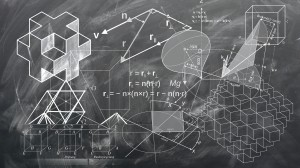Integrated Approaches to Mathematics Education (I&II)
This course enhancement project consisted of two related efforts. The first was a modification of a student-designed investigation into student thinking about a mathematical topic so that the topics were tied to the Common Core State Standards for Mathematics; data collection items were based on the CCSM, and, when possible, sample/released CCSSM test items were used. The second involved a unit of instruction in transformational geometry, with efforts to enhance the prospective teachers’ content and pedagogical content knowledge related to this topic (spanning two semesters).
Integrated Approaches to Mathematics Education I
Professor Natasha Speer
In the first semester, course enhancements focused on analyzing student thinking, via work samples, around key ideas in the CCSSM. We developed a multi-day unit on transformational geometry, which was used in both Integrated Approaches in Mathematics Education I and II.
The basic structure of the activity was:
- Preservice teachers did a Common Core task and debriefed about the mathematics in it. Then they examined some student thinking on the task (via interviews with students or written work) and categorized ways of thinking. Then they developed a task/lesson that could be used with students to help strengthen their understanding of some idea that was key to the item.
- The process above was repeated but with a different item, focused on ideas of congruence. And preservice teachers used a Common Core grading rubric to score and categorize some student sample written responses to the task so they could become familiar with the scoring process used by Common Core.
- Preservice teachers worked on and discussed some tasks that involved these ideas of symmetry as they appeared in lower-division undergraduate mathematics. This connects to ideas of mathematical “groups.”
- The process from (3) was repeated but this time the emphasis was on content at a somewhat more advanced level (upper division undergraduate courses).
These activities provided preservice teachers with opportunities to (a) become familiar with Common Core Standards, items and scoring rubrics, (b) develop and/or deepen their knowledge of mathematics associated with particular Standards, and (c) develop knowledge of student thinking related to particular Standards.
In addition, in this course, students used a Common Core sample item as the task for their clinical interviewing assignment. In the past, they have selected any task they wanted but to help familiarize them with the Common Core tasks and to help them developed knowledge of student thinking related to the Common Core content, they used a sample task in their interviews and used the sample scoring rubrics (if available) in part of the analysis work they did. They also linked the topic/content of their research project to the Common Core Standards.
Integrated Approaches to Mathematics Education II
Professor Eric Pandiscio
During the second semester this course enhancement project focused on: (1) the creation of a unit of instruction on transformational geometry (as described in CCSSM), so that students could study this content at a level of sophistication that was considerably deeper than that expected of secondary students; and (2) student use of assessment items from Smarter Balanced and PARCC to evaluate each others’ mathematical thinking on topics drawn directly from the Common Core.
- Created a unit of instruction in Transformational Geometry aligned with ideas described in the Common Core State Standards for Mathematics (CCSSM). The specific content centered around symmetry groups and their connection to motions of the plane. The focus of the work was on students identifying, describing, and analyzing rigid motions through group and permutation notation. As examples, two tasks that represent that nature of the work are: a) Using either the pictorial or permutation representation, describe the symmetries of a non-square rectangle, and b) Using a representation of your choosing, determine whether the symmetries of a non-square rectangle constitute a group. The rationale for incorporating this work is that Transformational Geometry receives more emphasis in the CCSSM than it has in other K-12 standards and curriculum frameworks over the past several decades. As a result, prospective teachers need opportunities to enhance their knowledge of student thinking in this area. In the course we used student work samples as evidence of student thinking around the key ideas the CCSSM outlines within the framework of transformational geometry.
- Designed activities in which students use assessment items from Smarter Balanced and PARCC to evaluate each others’ mathematical thinking on topics drawn directly from the Common Core. The task had multiple purposes: a) to enhance their ability to assess mathematical reasoning, b) to “Construct Viable Arguments and Critique the Reasoning of Others,” one of the Standards for Mathematical Practice in the CCSSM, and c) to become familiar, through direct experience, with the nature of the evaluation items that secondary students will be expected to know and be able to do. Evidence consisted of student work samples, instructor notes, and student pre-test and post-test of 10 items selected to represent of range of topics within transformational geometry. Plans for the next iteration of the course include a refined pre-test/post.
Course Materials
- Syllabus
- Samples of Instructional Materials:
- Samples of tasks:
This material is based in part upon work supported by the National Science Foundation under Grant Number DUE-1504551. Any opinions, findings, and conclusions or recommendations expressed in this material are those of the author(s) and do not necessarily reflect the views of the National Science Foundation.


